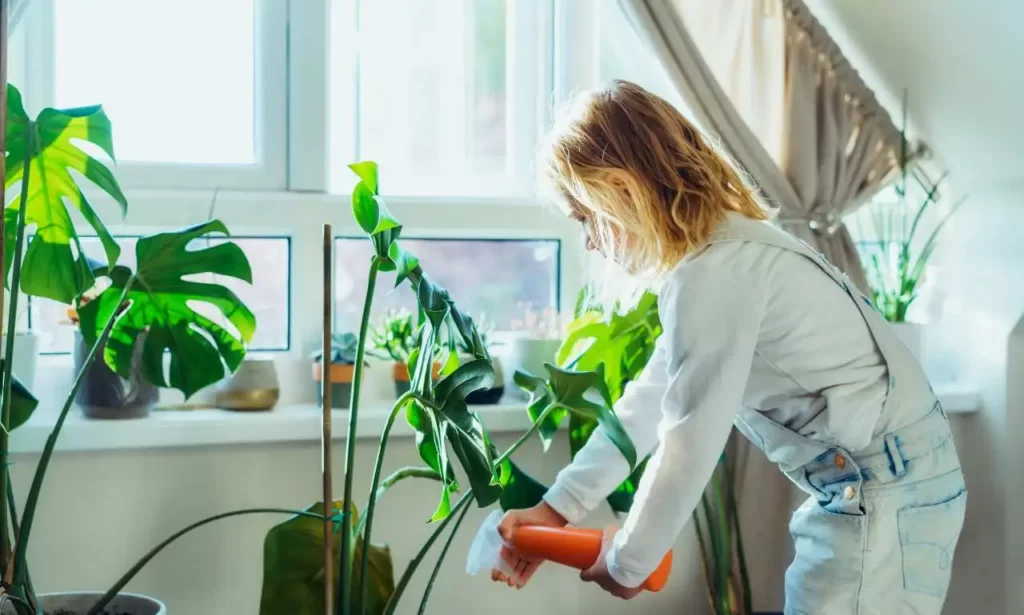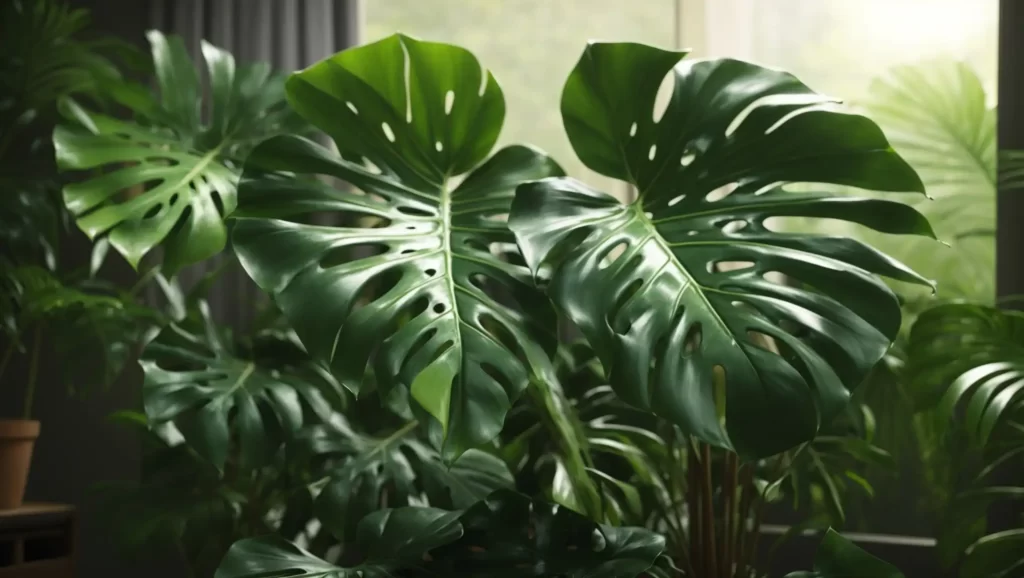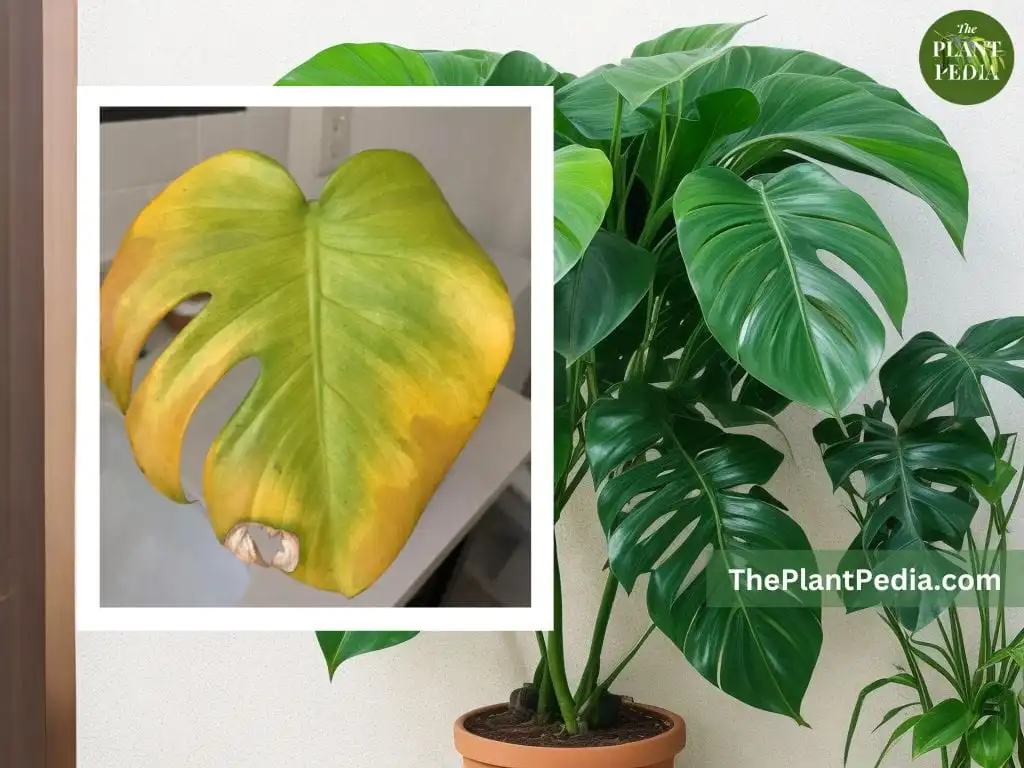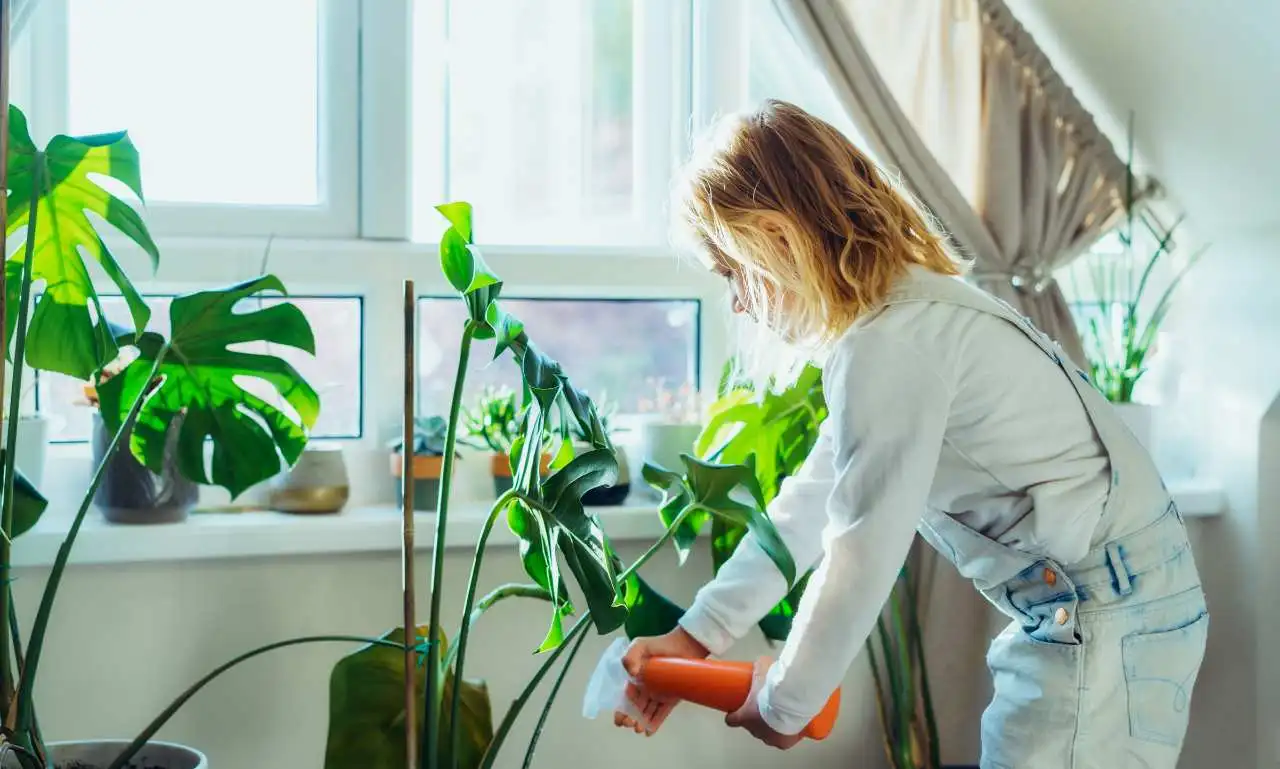Creating the perfect environment for your beloved Monstera is akin to offering it a slice of its native tropical habitat.
One crucial aspect of Monstera care revolves around humidity—a factor that profoundly influences its health and vibrancy.
Understanding the intricacies of how Monstera plants interact with humidity levels is essential for fostering their thriving growth.
In this detailed guide, we delve into the world of Monstera care, focusing on a fundamental question: Do Monsteras like humidity?
Let’s explore the nuances of humidity requirements, the benefits it bestows upon these lush beauties, and the various strategies to ensure your Monstera thrives in its newfound home.
Understanding Monsteras and Their Natural Habitat

The Origin Story:
Monsteras, often referred to as the Swiss cheese plant, hail from the lush, tropical regions of Central and South America.
These plants are native to countries like Mexico, Panama, and Colombia, where they thrive in the dappled sunlight of dense rainforests.
In these regions, the climate is characterized by consistently high temperatures and humidity levels ranging from 60% to 80%. This natural habitat provides critical insights into the conditions that are most conducive to their growth.
Humidity Levels:
Humidity plays a pivotal role in the life of a Monstera. In their native environment, these plants are accustomed to a humid atmosphere, which aids in their growth and overall health.
The lush surroundings of rainforests provide an abundance of moisture in the air, creating an environment where Monsteras can thrive.
The high humidity levels serve as a key factor in the Monstera’s ability to absorb water through its leaves, a process known as transpiration. Understanding this natural habitat is essential for replicating similar conditions in your home.
Adaptations to Humidity
Monsteras have evolved a range of adaptations to thrive in their humid native habitat. One of the most remarkable features is their development of aerial roots.
These specialized structures allow the plant to absorb moisture directly from the air, ensuring a constant supply of water even in environments with fluctuating humidity levels.
Additionally, the broad, fenestrated leaves of the Monstera serve a dual purpose. Not only do they capture sunlight for photosynthesis, but they also facilitate transpiration, allowing the plant to efficiently regulate its water balance.
By understanding these natural adaptations, you can better appreciate the Monstera’s affinity for humidity and the ways in which you can replicate these conditions in your own home.
Read: Monstera Watering in Winter: A Complete Guide.
Do Monsteras Like Humidity?
The answer is yes, Monsteras like humidity. Their affinity for humidity is deeply rooted in their natural habitat, where they originate from the lush tropical rainforests of Central and South America.
In these regions, humidity levels typically range from 60% to 80%, providing the ideal conditions for Monstera growth. However, the story doesn’t end here.
Let’s explore why humidity is vital for these captivating plants.
The Importance of Humidity for Monsteras
Humidity is not just a luxury but a necessity for Monsteras. Here’s why:
1. Water Absorption through Leaves: Monsteras are well-adapted to absorb water through their leaves, making them highly dependent on atmospheric moisture. In a dry environment, these plants have to work harder to maintain their hydration, which can result in stress and various issues such as brown leaf tips, wilting, and leaf drop.
2. Impact on Plant Physiology: Humidity levels directly influence the processes crucial for the health of Monsteras. Transpiration, the absorption of water and the release of water vapor through their leaves, is a fundamental process for these plants. Adequate humidity supports this process, ensuring the Monstera remains well-hydrated and healthy.
How Long Do Monsteras Like Humidity

Monsteras, being tropical plants, thrive in high-humidity environments. Ideally, they prefer humidity levels between 50% and 70%.
However, they can tolerate levels as low as 40% if necessary. It’s important to maintain suitable humidity consistently for your Monstera to thrive.
Providing a consistently humid environment is especially crucial for young or newly propagated Monsteras, as they are more sensitive to fluctuations in humidity levels.
As your Monstera matures, it may become more adaptable to slight variations in humidity, but it will still benefit from a relatively stable, higher-humidity setting.
Ultimately, it’s about mimicking the natural conditions of their native habitat, where they are accustomed to higher humidity levels.
By maintaining appropriate humidity levels, you’re creating an environment where your Monstera can thrive and exhibit its full beauty.
Monitoring your Monstera for signs of humidity-related stress is crucial:
Signs that Your Monstera Needs More Humidity:

- Brown leaf tips
- Wilting leaves
- Yellow leaves
- Crispy leaves
- Curling leaves
- Leaf drop
If you notice any of these signs, it’s a clear indicator that your Monstera is in need of a more humid environment. Addressing this promptly can make a significant difference in the health and vibrancy of your plant.
Techniques for Increasing Humidity
Now that we understand why humidity is crucial for Monsteras, let’s explore practical ways to provide the right moisture levels for your plant.
Use a Humidifier
A humidifier is a highly effective tool for increasing humidity levels in your home. It releases a fine mist of water vapor into the air, creating a more suitable environment for your Monstera.
When using a humidifier, it’s important to choose one appropriate for the size of the room and to monitor humidity levels to ensure they remain within the desired range.
Misting Your Plant Regularly
Misting is a quick and easy way to provide a boost of moisture to your Monstera. By spraying a fine mist of water onto the leaves, you mimic the natural conditions of a more humid environment.
However, it’s crucial to note that misting alone may not be sufficient, especially in drier climates. It’s best used in conjunction with other methods of humidity control.
Group Your Monstera with Other Plants
Plants naturally release moisture into the air through a process called transpiration. By grouping your Monstera with other plants, you create a microclimate that benefits all the plants involved.
This can be particularly effective in increasing humidity levels around your Monstera.
Place Your Monstera in a Bathroom or Kitchen
Bathrooms and kitchens tend to have higher humidity levels compared to other rooms in the house due to activities like showering and cooking.
If you have a bright spot in your bathroom or kitchen, consider placing your Monstera there. However, ensure it still receives the appropriate level of indirect light to avoid any adverse effects.
Use a Pebble Tray
A pebble tray is a simple yet effective method to increase humidity around your Monstera. By filling a shallow tray with pebbles and water, you create a reservoir of moisture that evaporates into the air.
When you place your Monstera pot on the pebble tray, it benefits from this added humidity. Be sure to regularly check and refill the tray as needed.
By employing these techniques, you can create an environment that closely mimics the natural habitat of Monsteras, allowing them to flourish and thrive in your home.
How to Care for Monsteras in Low-humidity Environments?
While Monsteras are known for their resilience, they can face challenges in low-humidity environments.
If you live in an area with dry air or during seasons when humidity drops, it’s crucial to provide extra care for your Monstera.
Here are some specialized tips to help your plant thrive in less humid conditions:
1. Watering Regimen
In low-humidity environments, it’s essential to maintain a consistent watering schedule. Check the soil regularly, and when the top inch is dry, water your Monstera thoroughly. Be sure to allow excess water to drain away to prevent root rot.
2. Fertilization Strategies
Regular fertilization is vital for Monstera health, especially in low-humidity settings. Use a balanced, water-soluble fertilizer diluted to half strength. This provides essential nutrients without overwhelming the plant.
3. Misting Routine
Increase humidity levels by misting your Monstera regularly. Use a clean spray bottle to deliver a fine mist of water to the leaves. Aim to mist early in the day to allow the leaves to dry before nightfall.
4. Placement in Bright Indirect Light
Ensure your Monstera receives adequate but indirect sunlight. Bright, filtered light is ideal. Avoid placing it in direct sunlight, as this can scorch the leaves, especially in drier environments.
5. Humidification Techniques
Consider utilizing a humidifier in the vicinity of your Monstera. This will help maintain a more favorable humidity level around the plant. Choose a humidifier size appropriate for the room and monitor humidity levels to ensure they stay within the desired range.
6. Pebble Tray Method
Employ a pebble tray to create a localized humid microclimate around your Monstera. Fill a shallow tray with pebbles and water, and place the pot on top. As the water evaporates, it will increase humidity levels near the plant.
7. Grouping with Other Plants
Cluster your Monstera with other plants, which collectively release moisture into the air through transpiration. This creates a small, humid zone beneficial for all the plants involved.
8. Monitor for Signs of Stress
Regularly inspect your Monstera for signs of humidity-related stress, such as brown leaf tips or wilting. If you notice these symptoms, it’s an indication that the humidity levels may need further adjustment.
By implementing these specialized care strategies, you can create a more hospitable environment for your Monstera, even in low-humidity conditions. Remember, a little extra attention goes a long way in ensuring the health and vitality of your beloved plant.
The Benefits of Increasing Humidity for Monsteras
Elevating humidity levels around your Monstera can lead to a plethora of advantages, not only enhancing the aesthetics but also promoting its overall health and vitality.
Here are several compelling benefits of providing your Monstera with a higher-humidity environment:
1. Healthier Leaves
When exposed to elevated humidity levels, Monstera leaves display a remarkable improvement in health. They are less prone to developing unsightly issues such as brown leaf tips, wilting, or curling. Instead, they exhibit a vibrant, lush appearance that is a testament to their well-being.
2. Accelerated Growth
Monsteras that thrive in a high-humidity environment tend to exhibit accelerated growth rates. This means more vigorous development of leaves, stems, and overall structure. It’s a visible sign of the plant’s contentment with its surroundings.
3. Increased Fenestration
Fenestration, characterized by the distinctive splits and holes in Monstera leaves, is a mark of maturity and robust health. A plant with abundant fenestration is generally considered more desirable among enthusiasts. Elevating humidity levels can serve as a catalyst in encouraging the growth of these captivating features.
4. Reduced Stress
High humidity levels significantly reduce the stress levels experienced by Monsteras. This translates into a lower likelihood of encountering problems like leaf drop or susceptibility to pests. A less stressed Monstera is better equipped to withstand environmental fluctuations and thrive in your care.
5. Enhanced Resilience
With increased humidity, your Monstera builds a stronger resilience to adverse conditions. It becomes better equipped to handle minor fluctuations in environmental factors, ensuring it remains robust and steadfast in its growth.
6. Improved Air Quality
As a byproduct of maintaining higher humidity levels, the overall air quality in the vicinity of your Monstera plant is enhanced. This can have positive effects on your own well-being, creating a more pleasant and healthful indoor environment.
7. Optimized Photosynthesis
With ample moisture in the air, Monstera leaves can more efficiently carry out the process of photosynthesis. This is crucial for the plant’s energy production and overall metabolic functions, contributing to its sustained growth and vitality.
Increasing humidity levels around your Monstera not only creates a more aesthetically pleasing plant but also bolsters its overall health and resilience. By providing the optimal conditions for growth, you’re ensuring that your Monstera thrives and graces your living space with its lush, vibrant presence.
How to Choose the Right Humidifier for Your Monstera
Selecting the appropriate humidifier for your Monstera is a crucial step in ensuring it receives the ideal moisture levels.
Here are some essential considerations to keep in mind when making your choice:
1. Size Matters
The size of the humidifier is a key factor to consider. It should be proportional to the size of the room where your Monstera resides. For smaller spaces, a compact humidifier will suffice. However, for larger rooms, opt for a more robust model with a higher moisture output.
2. Type of Humidifier
There are primarily two types of humidifiers to choose from: cool mist and warm mist.
- Cool Mist Humidifiers: These are more common and are generally considered safer for plants. They emit a cool, room-temperature mist, making them suitable for most environments.
- Warm Mist Humidifiers: These can be more effective at increasing humidity levels, but they emit a warm mist and require careful handling to avoid any potential harm to plants. They are generally recommended for use in areas where safety precautions can be ensured.
3. Additional Features
While not essential, certain features can enhance the convenience and effectiveness of a humidifier:
- Timers: Allow you to set specific operating durations, ensuring the humidifier runs at optimal times.
- Remote Controls: Enable you to adjust settings from a distance, which can be particularly useful for larger rooms or hard-to-reach areas.
- Built-In Humidistats: Automatically regulate humidity levels based on preset settings, providing a hassle-free approach to maintaining the ideal environment.
Humidifier Recommendations for Monsteras
Here are a few specific humidifiers that are known to be well-suited for Monstera plants:
- Levoit Classic 300S Smart Humidifier
- Notable for its smart capabilities, this humidifier allows for precise control over humidity levels, ensuring an optimal environment for your Monstera.
- Levoit Cool/Warm Mist Ultrasonic Air Vaporizer Humidifier for Plants
- Offering both cool and warm mist options, this versatile humidifier is designed to cater to various plant species, including Monsteras.
- Govee 6L Smart WiFi Humidifier
- Equipped with WiFi capabilities, this humidifier allows for remote monitoring and adjustments, providing an extra level of convenience.
- Movtip Dual Nozzle Mini Humidifier
- This compact yet efficient humidifier features dual nozzles for even mist distribution, making it an excellent choice for smaller spaces.
These recommended humidifiers are not only affordable but also user-friendly. They produce a gentle mist that is well-suited for the delicate leaves of Monsteras, ensuring they receive the moisture they crave for optimal growth and health.
How to Use a Humidifier for Monsteras
Now that you’ve chosen the right humidifier for your Monstera, it’s crucial to use it effectively to provide the optimal humidity levels. Here’s a step-by-step guide to ensure your Monstera benefits from the added moisture:
1. Proper Placement
Position the humidifier in close proximity to your Monstera plant. The closer the humidifier is to the plant, the more effectively it can raise humidity levels in the immediate vicinity.
2. Choose the Right Water Source
Always use distilled water to fill your humidifier. Tap water can contain minerals and impurities that, over time, may harm your Monstera’s leaves. Using distilled water ensures your plant receives pure, clean moisture.
3. Set the Desired Humidity Level
Most modern humidifiers are equipped with a built-in humidistat, allowing you to precisely control the humidity levels. Adjust the settings to the specific range that best suits your Monstera, ideally between 50% and 70% humidity.
4. Monitor Humidity Levels
Keep an eye on the humidity levels in the room, especially in close proximity to the Monstera. A hygrometer can be a valuable tool for accurate measurements. Adjust the humidifier settings as needed to maintain the desired level.
5. Regular Maintenance is Key
Empty and clean the humidifier at regular intervals. This prevents the growth of mold and bacteria, which can be harmful to both your Monstera and your health. Follow the manufacturer’s instructions for cleaning and maintenance.
6. Keep the Air Circulation in Mind
While it’s essential to provide adequate humidity, ensure there is still some air circulation around your Monstera. Stagnant air can lead to other issues, so strike a balance between humidity and airflow.
7. Adjust as Needed
Be attentive to your Monstera’s response to the increased humidity. Monitor the leaves for signs of improved health, such as a reduction in brown tips or an increase in vibrancy.
By following these steps, you can effectively utilize your humidifier to create a more favorable environment for your Monstera. Consistent care and attention to humidity levels will go a long way in promoting the health and well-being of your beloved plant.
How Often Should I Mist My Monstera
Misting your Monstera plant can be a beneficial way to increase humidity around it, especially in drier environments.
However, it’s important to mist at the right time to maximize its effectiveness and avoid potential issues. Here are some key considerations for when to mist your Monstera:
1. Early Morning:
The optimal time to mist your Monstera is in the early morning. This allows the leaves to absorb the moisture and benefit from it throughout the day.
Misting in the morning also gives the leaves ample time to dry before evening, reducing the risk of fungal growth or other moisture-related problems.
2. Avoid Misting in the Evening:
It’s generally recommended to avoid misting your Monstera in the evening or at night. This is because damp leaves in low light conditions can be more susceptible to mold, mildew, and other potential issues.
Ensuring the leaves have enough time to dry before nightfall is crucial.
3. Mist on Non-Watering Days:
If you have a regular watering schedule for your Monstera, consider misting on days when you’re not planning to water. This provides an additional boost of moisture without over-saturating the soil.
4. Adjust Based on Humidity Levels:
If you live in an area with consistently low humidity, you may choose to mist more frequently. However, if you’re using other methods to maintain adequate humidity, such as a humidifier or a pebble tray, you may not need to mist as often.
5. Monitor Plant’s Response:
Pay attention to how your Monstera responds to misting. If you notice an improvement in the overall health and appearance of the leaves, it’s a good indication that your misting routine is beneficial.
6. Consider Other Humidification Methods:
Misting can be a helpful supplementary method, but it’s important to remember that it’s not the only way to increase humidity.
Using a humidifier, grouping plants together, or utilizing a pebble tray are additional strategies that can be more effective for maintaining consistent humidity levels.
Remember, misting is just one tool in your arsenal for creating a suitable environment for your Monstera. Combining it with other humidity-boosting techniques can provide a more comprehensive solution for your plant’s needs.
How to Properly Mist Your Monstera Plant
Misting your Monstera is a simple yet effective way to boost humidity levels around the plant. However, there are certain techniques to keep in mind to ensure it’s done correctly.
Here’s a step-by-step guide on how to mist your Monstera:
1. Choose the Right Spray Bottle
Select a spray bottle with a fine mist setting. This ensures that the water is dispersed in fine droplets rather than larger, heavier droplets. Fine mist helps prevent water from pooling on the leaves, which can lead to issues like fungal growth.
2. Mist Early in the Day
The best time to mist your Monstera is in the morning. This allows the leaves to absorb the moisture and benefit from it throughout the day. Additionally, it gives the leaves ample time to dry before nightfall, reducing the risk of moisture-related problems.
3. Cover Both Sides of the Leaves
When misting, make sure to target both the tops and undersides of the leaves. This helps to evenly distribute the moisture and ensure all parts of the plant receive the benefits of increased humidity.
4. Avoid Over-Misting
While misting is beneficial, it’s important not to overdo it. Over-misting can lead to excessive moisture on the leaves, which can promote conditions like leaf rot. Aim for a light misting that provides a gentle layer of moisture without saturating the plant.
5. Monitor Humidity Levels
Pay attention to the overall humidity levels in the room where your Monstera is located. If you’re misting regularly but still struggling with low humidity, consider supplementing with other humidity-boosting methods, such as using a humidifier or placing your plant near a pebble tray filled with water.
6. Adjust Misting Frequency
The frequency of misting can vary depending on factors like the local climate and indoor conditions. If you’re in an area with naturally high humidity, you may not need to mist as often. Conversely, in drier environments, more frequent misting may be beneficial.
By following these steps, you can ensure that your Monstera receives the right amount of moisture through misting, contributing to its overall health and well-being. Remember, it’s just one part of creating an ideal environment for your plant. Combining misting with other humidity-boosting strategies can provide the best results for your Monstera.
Additional Methods to Increase Humidity for Monsteras
While using a humidifier and misting are effective ways to boost humidity, there are other strategies you can employ to create a more favorable environment for your Monstera.
Here are some additional methods:
1. Grouping with Other Plants
Plants release moisture into the air through a process called transpiration. By grouping your Monstera with other plants, you create a microclimate where humidity levels are naturally elevated.
This can be particularly effective in increasing overall humidity around your Monstera.
2. Utilize High-Humidity Rooms
Certain rooms in your home naturally have higher humidity levels. Bathrooms and kitchens, for example, are often more humid due to activities like showering or cooking.
If you have a well-lit spot in your bathroom or kitchen, consider placing your Monstera there to take advantage of the naturally higher moisture content in the air.
3. Pebble Tray Method
A pebble tray is a straightforward and effective way to increase humidity around your Monstera. Here’s how to do it:
- Fill a shallow tray with small, clean pebbles.
- Add water to the tray, but ensure the water level is below the surface of the pebbles.
- Place your Monstera pot on top of the pebbles.
As the water in the tray evaporates, it adds moisture to the surrounding air, creating a more humid microclimate around your plant.
4. Consider a Terrarium or Enclosure
Creating a closed environment, such as a terrarium or glass enclosure, can help maintain higher humidity levels around your Monstera.
Be mindful, however, to monitor the conditions inside the enclosure to prevent issues like excessive condensation.
5. Use a Room Humidifier
If you’re not specifically concerned with one plant but rather the overall humidity levels in a room, a room humidifier can be an excellent option. This device releases moisture into the air, benefiting all the plants in the vicinity.
6. Monitor and Adjust
Regularly monitor the humidity levels around your Monstera. This can be done using a hygrometer, a device that measures humidity. Depending on your observations, adjust your chosen method to maintain the desired humidity range.
By combining these methods with the use of a humidifier or misting, you can create a consistently humid environment that supports the health and vibrancy of your Monstera plant. Remember, it’s about finding the right balance for your specific plant and living conditions.
Common Mistakes to Avoid When Increasing Humidity for Monsteras
While increasing humidity is crucial for the health of your Monstera, there are common mistakes that should be avoided to ensure your efforts are beneficial rather than harmful.
Here are some key pitfalls to steer clear of:
1. Using Tap Water
Using tap water for misting or in your humidifier can introduce minerals and impurities to your Monstera, which can harm its leaves over time. Instead, opt for distilled water or collected rainwater, which are free from harmful substances.
2. Over-Misting
While misting is a helpful way to boost humidity, overdoing it can lead to excessive moisture on the leaves, potentially causing issues like leaf rot. Aim for a light misting once or twice a day, and ensure the leaves have enough time to dry between misting sessions.
3. Placing in Direct Sunlight
Direct sunlight can be too intense for your Monstera and may lead to scorched leaves. Opt for a spot with bright, indirect light to avoid any damage. If you’re in a particularly sunny area, consider using sheer curtains to filter the light.
4. Neglecting Regular Watering
Even with increased humidity, it’s important to maintain a regular watering schedule. Monsteras need consistent hydration, especially in dry climates. Water deeply when the top inch of soil is dry to ensure your plant remains adequately nourished.
5. Ignoring Signs of Over-Humidity
While increasing humidity is crucial, it’s equally important to be attentive to your plant’s response. If you notice signs of over-humidity, such as mold growth on the soil surface or droplets forming on the leaves, adjust your humidification methods accordingly.
6. Neglecting Air Circulation
While creating a humid environment is important, be cautious not to create stagnant air. Adequate air circulation is necessary for overall plant health. Use fans on low settings to ensure the air around your Monstera remains fresh and well-circulated.
7. Failing to Monitor Humidity Levels
Relying solely on one method to increase humidity may not always yield the desired results. It’s crucial to regularly monitor humidity levels, especially in different seasons or climates, and adjust your methods accordingly.
By avoiding these common mistakes, you can effectively create a humid environment that supports the health and growth of your Monstera plant. Remember, it’s about finding the right balance for your specific plant and living conditions.
Do Monsteras Like Bathrooms?
Yes, Monsteras like bathrooms. The higher humidity levels in bathrooms provide an environment that closely mimics their natural tropical habitat.
Additionally, the occasional steam from showers or baths further contributes to maintaining suitable moisture levels.
However, it’s important to ensure that the bathroom receives some indirect light, as Monsteras still need adequate light for photosynthesis.
Placing your Monstera in a bright spot within the bathroom, away from direct sunlight, can create an optimal environment for the plant to flourish.
Should I Mist My Monstera Everyday?
No, you shouldn’t mist your Monstera plant every day. While misting can be beneficial for increasing humidity levels around your plant, it’s important to do so in moderation and as part of a broader approach to maintaining suitable humidity.
Misting should not be relied upon as the sole method for increasing humidity. Using a humidifier or grouping your Monstera with other plants are more effective ways to create a consistently humid environment.
If you do choose to mist your Monstera, do it lightly and evenly. Additionally, avoid misting the leaves in the evening to prevent potential issues like fungal growth. A good rule of thumb is to mist your Monstera once or twice a week, or more often if you live in an area with very low humidity levels.
Remember, balance is key in providing the right amount of moisture for your Monstera’s optimal growth and health.
Conclusion
So, do Monsteras like humidity? Absolutely. As native inhabitants of lush, tropical landscapes, Monsteras thrive in environments where humidity levels are on the higher side.
Adequate humidity not only contributes to their overall health and vibrancy but also supports essential processes like transpiration and photosynthesis.
Understanding how to manage humidity effectively is a cornerstone of successful Monstera care.
Remember, while misting can provide a quick boost, it’s just one tool in your arsenal.
Supplementing with methods like humidifiers, grouping with other plants, or utilizing pebble trays creates a more stable and consistent humidity level for your Monstera to flourish.
With these strategies in place, you’ll be well on your way to providing your Monstera with the thriving, tropical haven it craves.

